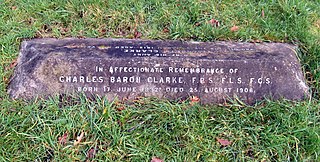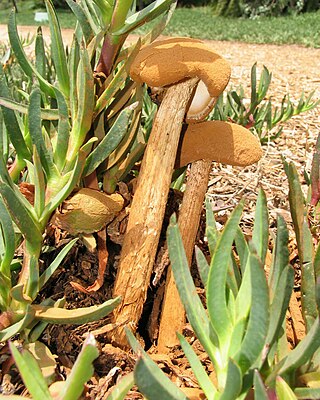Related Research Articles

Rolf Singer was a German-born mycologist and one of the most important taxonomists of gilled mushrooms (agarics) in the 20th century.

Lepiota is a genus of gilled mushrooms in the family Agaricaceae. All Lepiota species are ground-dwelling saprotrophs with a preference for rich, calcareous soils. Basidiocarps are agaricoid with whitish spores, typically with scaly caps and a ring on the stipe. Around 400 species of Lepiota are currently recognized worldwide. Many species are poisonous, some lethally so.

The Agaricaceae are a family of basidiomycete fungi and include the genus Agaricus, as well as basidiomycetes previously classified in the families Tulostomataceae, Lepiotaceae, and Lycoperdaceae.

The Psathyrellaceae are a family of dark-spored agarics that generally have rather soft, fragile fruiting bodies, and are characterized by black, dark brown, rarely reddish, or even pastel-colored spore prints. About 50% of species produce fruiting bodies that dissolve into ink-like ooze when the spores are mature via autodigestion. Prior to phylogenetic research based upon DNA comparisons, most of the species that autodigested were classified as Coprinaceae, which contained all of the inky-cap mushrooms. However, the type species of Coprinus, Coprinus comatus, and a few other species, were found to be more closely related to Agaricaceae. The former genus Coprinus was split between two families, and the name "Coprinaceae" became a synonym of Agaricaceae in its 21st-century phylogenetic redefinition. Note that in the 19th and early 20th centuries the family name Agaricaceae had far broader application, while in the late 20th century it had a narrower application. The family name Psathyrellaceae is based on the former Coprinaceae subfamily name Psathyrelloideae. The type genus Psathyrella consists of species that produce fruiting bodies which do not liquify via autodigestion. Psathyrella remained a polyphyletic genus until it was split into several genera including 3 new ones in 2015. Lacrymaria is another genus that does not autodigest its fruiting bodies. It is characterized by rough basidiospores and lamellar edges that exude beads of clear liquid when in prime condition, hence the Latin reference, lacryma (tears).

Charles Baron Clarke was a British botanist. He was born at Andover, the eldest son of Turner Poulter Clarke. He was educated at King's College School, London, and at Trinity and Queens' Colleges, Cambridge. He began the study of law at Lincoln's Inn in 1856 and was called to the bar in 1860. He lectured in mathematics at Presidency College, Calcutta, from 1857 to 1865. Clarke was Inspector of Schools in Eastern Bengal and later of India, and superintendent of the Calcutta Botanical Garden from 1869 to 1871.

Hans Schinz was a Swiss explorer and botanist who was a native of Zürich.

Handkea is a genus of puffball mushrooms in the family Agaricaceae. In 1989, German mycologist Hanns Kreisel described the genus Handkea to include species of Calvatia with distinct microscopic features, including a unique type of capillitium, with curvy slits instead of the usual pores. Although accepted by some authors, the genus concept has been rejected by others.

Battarrea is a genus of mushroom-producing fungi. The genus used to be classified in the family Tulostomaceae until molecular phylogenetics revealed its affinity to the Agaricaceae. Species of Battarrea have a peridium that rests atop an elongated, hollow stipe with a surface that tends to become torn into fibrous scales. Inside the peridium, the gleba consists of spherical, warted spores, and a capillitium of simple or branched hyphal threads that have spiral or angular thickenings. The genus is named after Italian priest and naturalist Giovanni Antonio Battarra.
Barcheria is a fungal genus in the family Agaricaceae. This is a monotypic genus, containing the single sequestrate species Barcheria willisiana, found in western Australia.
Endoptychum is a genus of secotioid fungi in the family Agaricaceae. Like the majority of secotioid taxa, the individual species of Endoptychum are thought to be recent mutations from agaricoid species, hence, Endoptychum is likely not a valid monophyletic genus.

Gastropila is a genus of fungi in the family Agaricaceae. The genus, described in 1973, contains four puffball-like species distributed in the Americas.
Metrodia is a genus of fungi in the family Agaricaceae. It was circumscribed in 1971 by mycologist Jörg H. Raithelhuber, with M. collybioides as the type species. M. excissa was added to the genus in 1983.

Montagnea is a genus of fungi in the family Agaricaceae. The genus has a widespread distribution in subtropical dry areas, and contains six species. Montagnea was circumscribed by Swedish mycologist Elias Magnus Fries in 1836.
Queletia is a genus of fungi in the family Agaricaceae. The genus was described by Elias Magnus Fries in 1872. Fruit bodies of Queletia species are roughly spherical with a stipe-like base. They have a thin outer skin (peridium) and a harder inner skin that breaks into small pieces with age. The genus is named after French mycologist Lucien Quélet (1832-1899).

Ripartitella is a genus of fungi in the family Agaricaceae. The genus was circumscribed by Rolf Singer in Mycologia vol.39 on page 85 in 1947.
Schinzinia is a fungal genus in the family Agaricaceae. It is a monotypic genus, containing the single species Schinzinia pustulosaFayod. The genus and the species were circumscribed by Victor Fayod in Ann. Sci. Nat. Bot. ser.7, vol.9 on page 365 in 1889.
Singerina is a fungal genus in the family Agaricaceae. It is a monotypic genus, containing the single species Singerina indica, found in Maharashtra, southwest India.

Vascellum is a genus of puffball fungi in the family Agaricaceae. The genus was defined by Czech mycologist František Šmarda in 1958.
James Walton Groves was a Canadian mycologist born in Kinburn, Ontario on October 18, 1906 to John James and Laura Groves. He displayed an early interest in education and learning. He taught himself the alphabet from a decorated bowl, and impressed visitors to the family farm by reading aloud the newspaper by age four. In 1918, his father John sustained an injury from an accident and the family moved to Ottawa. He then attended Lisgar High School and later the Ottawa Normal School with the intention of teaching for a career. From 1926 to 1928 he taught public school, denying offers at universities and encouraging his students to pursue graduate educations in mycology. A Summer job with the Canada Department of Agriculture in 1929 as a plant disease investigator is credited by him as an introduction to the field of botanical research and jumpstarting his research career. In 1930 he graduated from Queen's University for biology and a minor in chemistry with honors. Similar roles were held throughout his education while he earned his M.A. from the University of Toronto in 1932, and his Ph.D. in 1935. Many Summers were also spent at Lake Timagami, where he worked for a year after earning his Ph.D with H.S. Jackson.
References
- ↑ Wright JE. (1975). "Smithiogaster, a new genus of agaricoid Gasteromycetes". Beihefte zur Nova Hedwigia: 359–364.
- ↑ Burkhardt, Lotte (2022). Eine Enzyklopädie zu eponymischen Pflanzennamen [Encyclopedia of eponymic plant names](pdf) (in German). Berlin: Botanic Garden and Botanical Museum, Freie Universität Berlin. doi:10.3372/epolist2022. ISBN 978-3-946292-41-8 . Retrieved January 27, 2022.